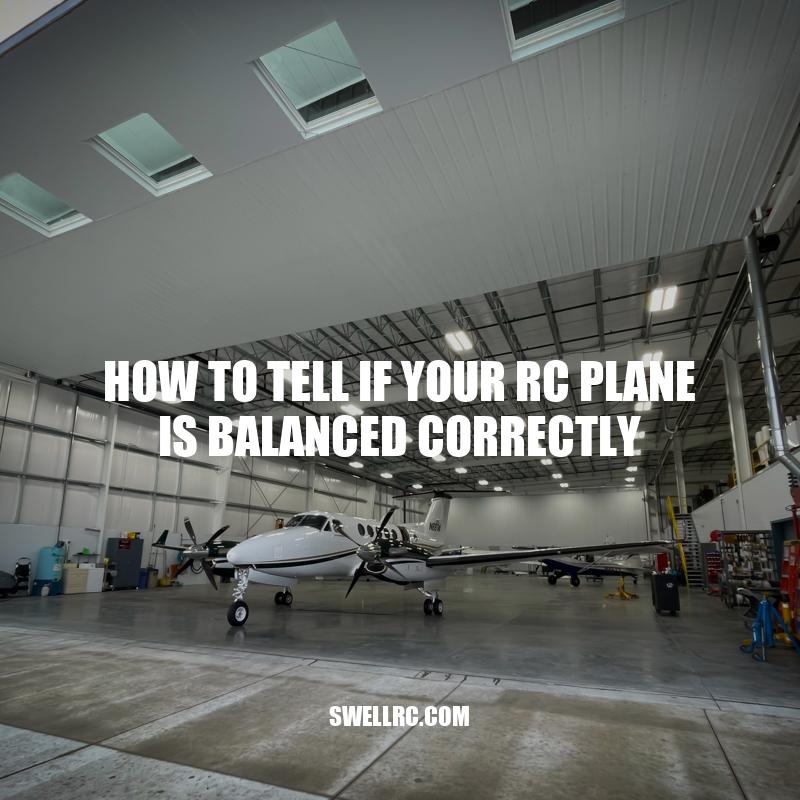RC Plane Balancing: How to Ensure Proper Weight Distribution and Center of Gravity
RC planes are a fun way to enjoy the beauty of flying without ever having to leave the ground. Building an RC plane is an exciting project, and successfully flying one can be an achievement in itself. However, the key to a successful and safe flight is to ensure that your RC plane is balanced correctly. A properly balanced RC plane will give you a smoother and more stable flight experience. An out-of-balance plane can cause unwanted vibrations, which may lead to safety issues like the loss of control and crashes. Therefore, it is essential to check if your RC plane is balanced before attempting flight. In this guide, we’ll explore how to check if your RC plane is balanced correctly, and provide tips on how to fix any issues detected during the process. By following our tips, you can ensure that your RC plane is always balanced, safe, and ready for a fun and enjoyable flight.
Locating the Center of Gravity (CG)
The center of gravity (CG) is the point where the weight of the airplane is balanced. Finding the CG is the first step in checking if your RC plane is balanced correctly. Here’s how to locate the CG of your RC plane:
- Refer to the manufacturer’s instructions for CG location
- Use a CG calculator or smartphone app to determine the proper location
- Balance the RC plane laterally by suspending it from two fingertips under its wings
- Move the fingers until the plane balances horizontally and doesn’t tip in any direction. The spot where you placed the fingers is the CG location
There are several websites and smartphone apps available that can help you determine the CG of your RC plane. These tools allow you to enter the length of the wing from the leading edge to determine the CG location. Some manufacturers also provide CG location in their user manual. Once you know the CG location, you can make adjustments to ensure that your RC plane is balanced correctly.
What is the best center of gravity for an RC plane?
– The center of gravity (CG) is the point where the plane balances horizontally
– The ideal CG varies by plane and can be found in the manufacturer’s manual or online forums
– As a general rule, a slightly forward CG is better for stability while a slightly rearward CG increases maneuverability
– It is important to check the CG before every flight and adjust as necessary to ensure safe and stable flying
For more information on RC planes and flying tips, check out websites like RCGroups.com or products like “The Complete Guide to RC Plane”.
Ensuring Proper Weight Distribution
Proper weight distribution is crucial for ensuring that an RC plane is balanced correctly. Here are some tips to ensure that the weight is evenly distributed on the plane:
| Tip | Description |
|---|---|
| Balance the propeller and spinner | A propeller that is out of balance can cause a vibration that distorts the plane’s balance. Balancing the propeller can help you prevent this issue. |
| Add weight to the tail | If the CG is too far forward, add weight to the tail to help shift the balance backward. |
| Check the battery weight | Make sure that the battery weight is evenly distributed and not affecting the balance of the plane. |
Interesting fact: In some advanced airplanes, weight distribution is so important that it can be adjusted during flight to maintain balance.
One product that can help with weight distribution is the Smart Balancer. It’s a device that accurately measures the weight of different parts of the RC plane and helps you adjust and balance the weight. Some online stores also offer weights of different sizes and shapes that can easily be attached to the plane to help achieve proper weight distribution.
How do you tell if your RC plane is balanced correctly?
To ensure that your RC plane operates smoothly and effectively, it is important to keep it balanced. Here are some ways to tell if your RC plane is balanced correctly:
- Perform a finger test by placing your index finger under the plane’s wing and check if the plane tilts in any direction. Adjust the weight accordingly to ensure that the plane remains level.
- Use a smartphone app or a leveling tool to determine whether your plane sit level or not.
- Ensure that the center of gravity of the plane is aligned with the manufacturer’s recommendation.
Remember to always check and balance your RC plane before each flight, and make any necessary adjustments to ensure that you have a safe and enjoyable flying experience.
For more information, visit Model Airplane News or Horizon Hobby.
Performing a Flight Test
A flight test is the best way to determine if your RC plane is balanced correctly. Here are some tips for performing a flight test:
| Tip | Description |
|---|---|
| Check the takeoff | A plane that pulls to one side during takeoff might suggest an issue with weight distribution or a misaligned landing gear. |
| Check the climb | If the plane climbs too steep or too shallow, it may indicate an issue with the CG. Adjust the weight distribution as needed. |
| Check stability | A properly balanced RC plane should remain stable in the air with minimal input. Check if your plane remains stable while in flight. |
It’s important to note that a flight test should only be performed with proper safety measures in place, such as ensuring the area is clear of people and structures. It’s also recommended to perform the test in ideal environmental conditions, such as low winds and good weather.
One popular website that offers resources for RC pilots is RCGroups.com. They have a community forum, blogs, and a classifieds section where you can find planes, parts, and equipment. If you’re interested in improving your RC flying techniques, you can also find resources on their website.
How do you check the CG on a RC plane?
To check the center of gravity on a radio-controlled plane, follow these simple steps:
- Find the recommended CG location for your plane in the manual or online.
- Balance your plane using a CG balance tool or by placing your fingers under the wings at the recommended CG location.
- If the plane is too nose-heavy, move the battery or receiver towards the tail. If the plane is too tail-heavy, move the battery or receiver towards the nose.
- Check the CG again after making any adjustments.
It’s important to get the CG just right to ensure stable flight. If you’re struggling to find the right balance, there are many resources available online, such as RC Groups and RC Universe, where experienced RC pilots can offer advice and support.
Adjustments and Fixes
If your RC plane is not balanced properly during a flight test, there are some adjustments and fixes you can make to correct the imbalance:
- Shift weight: Move batteries or other components to adjust the weight distribution.
- Add weight: Use adding small weights (like scotch tape or clay) to the nose or tail to adjust the CG position
- Repair or replace parts: If parts or components are damaged, such as the landing gear or wing, repair or replace them to resolve the imbalance.
- Check propeller balance: An unbalanced propeller can also cause flight issues, make sure that both blades have the same weight, they are secure and it doesn’t have any damages.
Remember to re-test after making any adjustments or fixes. If your plane still does not balance properly, consider seeking the assistance of an experienced RC pilot or consulting an RC forum, such as RC Universe or RC Groups, to troubleshoot the issue.
One product that can help with weight shifting is the Du-Bro Tru-Spin Prop Balancer. This device helps you balance your propellers with a series of cone adapters and can handle various sizes. Other helpful tools include digital scales to measure weight and CG, and a laser level to confirm if your RC plane is level on a flat surface. These can be found on online hobby shops like Horizon Hobby or Tower Hobbies.
How do you balance a propeller hub?
Balancing a propeller hub is an important maintenance task that helps improve performance and reduces wear and tear on the engine. Here are the steps to balance a propeller hub:
- Remove the propeller from the engine and place it on a balancing stand.
- Determine the heavy blade by measuring the distance from the tip of each blade to a fixed point on the stand.
- Add weight to the light blade by attaching a temporary weight to the blade.
- Re-measure the distance of each blade to determine if the weight has balanced the propeller hub.
- Remove the temporary weight and add a permanent weight in the exact location where the temporary weight was attached.
- Re-install the propeller on the engine and test for proper balance.
Note: If you’re not confident in your ability to balance a propeller hub yourself, consult with a professional mechanic or refer to the manufacturer’s instructions.
For products and services related to propeller maintenance and repair, visit websites such as boatus.com or myboatus.com.
Additional Tips
Proper storage and transportation of your RC airplane can also impact its balance, stability and eventual performance. Here are some additional tips:
Storage:
- Keep the wings level and securely attached when storing your RC plane.
- Avoid storing the plane in an overly humid environment.
- Keep the RC plane away from heat sources and direct sunlight, as temperature can affect glue and plastic parts.
Transportation:
- Use a padded carrying case or box to protect your RC plane during transport.
- Avoid stacking other items on top of the plane during transport.
- Avoid transporting the plane in a hot car or under direct sunlight, as the temperature can affect glue and plastic parts.
For added accuracy in balancing your RC plane, you can use a balance beam. A balance beam allows for more precise CG calculations and is particularly useful for planes with a narrow fuselage. You can find balance beams for RC planes on hobby shop websites like Motion RC and AMain Hobbies.
Always start with a balanced plane before making changes or upgrades. When making changes, stick to one modification at a time and then re-check the balance before moving on to the next modification. With careful attention and patience in checking, balancing, and maintaining your plane, you’ll be able to fly your RC plane with confidence, stability and enjoyment!
How do you transport an RC plane?
Transporting an RC (Radio-Controlled) plane can be daunting and risky if not done correctly. Here are some tips on how to transport your RC plane easily and safely:
- Choose the right container: Select a sturdy box or a hardshell carry case big enough to fit your plane without cramming it in. Make sure it is weather-resistant and has enough padding to protect your plane.
- Disassemble the plane: Remove propellers, wings, and other detachable parts before packing the plane. Label each part for easy assembly.
- Wrap the plane: Wrap your plane in bubble wrap and secure it with tape. Make sure the plane cannot move inside the container.
- Secure the container: Close the box/case properly and label it as “fragile” or “handle with care.”
- Carry-on or check-in: Check with your airline if you can carry the plane as carry-on luggage. Otherwise, check it in as fragile cargo.
If you are looking for a suitable box or a hardshell carry case, check online retailers like Amazon or hobby shops that specialize in RC planes. They have a wide range of cases and boxes designed for RC planes.
Conclusion
Checking if your RC plane is balanced correctly is crucial for safe and enjoyable flying. Taking the time to properly balance your RC plane before each flight can help you avoid crashes and increase the lifespan of your plane. Remember, the center of gravity and weight distribution on your plane must be balanced to achieve optimum performance during a flight.
Learning how to balance an RC plane can seem daunting at first, but with the information that we’ve covered, and a little bit of practice, you’ll be well on your way to successfully balancing your RC plane each and every time.
To recap, the steps to following to ensure your RC plane is balanced correctly include:
- Locating the center of gravity on the RC plane and making sure it is within the recommended range
- Ensuring proper weight distribution
- Performing a flight test to confirm the balance before flight
- Making any necessary adjustments or fixes to achieve balance
- Maintaining the balance of your RC plane during storage and transport
By following these tips, your RC flying experience will be much more enjoyable and rewarding.



